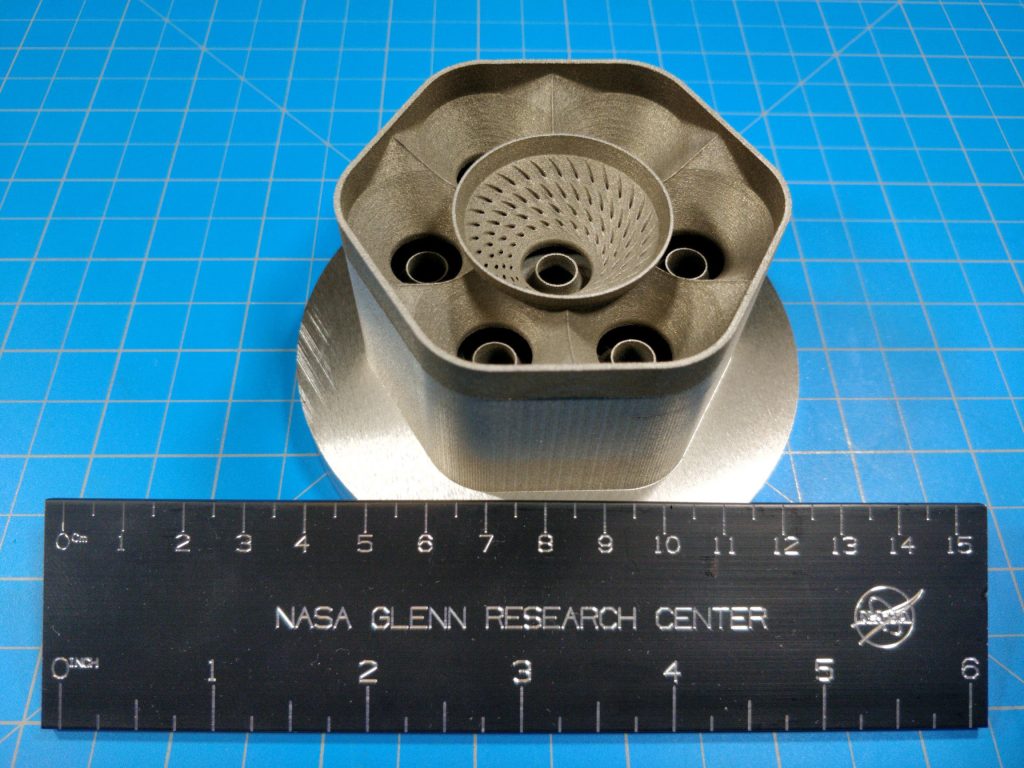NASA, the US National Aeronautics and Space Administration, has developed an all-new metal 3D printing alloy specially designed for use in high-performance aerospace systems.
Combining strength and durability, GRX-810 is an example of an oxide dispersion strengthened (ODS) alloy: a metal containing nanoscale oxide particles. The material can reportedly withstand temperatures of over 1090°C (2000°F), all while being more malleable than existing aerospace alloys.
NASA intends to use its latest innovation to 3D print high-temperature components for systems such as rocket engines, claiming it can ultimately enable improved fuel efficiency and lower maintenance costs. The agency has already used the alloy to 3D print a turbine engine combustor, a monolithic part designed to mix fuel and air.
Dale Hopkins, deputy project manager of NASA’s Transformational Tools and Technologies project, said, “The nanoscale oxide particles convey the incredible performance benefits of this alloy.”

GRX-810: a wonder alloy?
Owing to the harsh nature of outer space, NASA’s materials R&D efforts aim to enable enhanced mechanical properties in extreme environmental conditions. GRX-810 is the epitome of this, as it boasts ‘remarkable performance improvements’ over many of today’s leading alloys such as Inconel.
For example, at 1090°C, GRX-810 has twice the fracture resistance, three and a half times the ductility and malleability, and over 1,000 times the durability under stress when compared to ‘state-of-the-art alloys’.
“This breakthrough is revolutionary for materials development. New types of stronger and more lightweight materials play a key role as NASA aims to change the future of flight,” adds Hopkins. “Previously, an increase in tensile strength usually lowered a material’s ability to stretch and bend before breaking, which is why our new alloy is remarkable.”
A new alloy development process
GRX-810’s impressive blend of characteristics is due, in large part, to NASA’s new alloy development process. In this case, 3D printing technology was combined with thermodynamic modeling to achieve the material’s breakthrough performance.
ODS alloys tend to be difficult and costly to develop, so NASA’s researchers initially had to use computational models to fine-tune GRX-810’s composition. The team leveraged thermodynamic modeling to determine exactly which metals to combine and in what amounts. Then, the researchers utilized laser-based 3D printing to uniformly disperse the nanoscale oxides throughout the alloy’s matrix, which is what provides the temperature resistance and strength properties.
According to Hopkins, the process of ODS development usually takes years and is largely based on trial-and-error. Using this new combination of computational modeling and 3D printing, the researchers managed to slash the development time down to just a matter of weeks. In the case of GRX-810, the thermodynamic modeling approach allowed the NASA team to discover the optimal alloy composition in just 30 simulations.
“Applying these two processes has drastically accelerated the rate of our materials development. We can now produce new materials faster and with better performance than before,” said Tim Smith, a material research scientist at NASA’s Glenn Research Center in Cleveland.

The wider aerospace sector is no stranger to metal 3D printing technology. Just this month, propulsion system manufacturer Aerojet Rocketdyne used 3D printing to optimize a key component of its Reaction Control System (RCS) quad thruster with the help of nTopology’s design software. The firm’s new space engine part is now 67% lighter while also reducing the overall production cost of the thruster by 66% to enable faster and more sustainable lunar exploration.
Elsewhere, aerospace giant Boeing recently unveiled a new high-throughput 3D printing facility for the production and testing of small satellites. Spanning one million square feet, the facility is housed within the world’s largest satellite factory in El Segundo and will be powered by Boeing’s subsidiary Millennium Space Systems. In order to increase the rapid delivery timelines for small satellites, the facility will 3D print entire space-qualified satellite buses and is expected to be fully operational in late 2022.
Subscribe to the 3D Printing Industry newsletter for the latest news in additive manufacturing. You can also stay connected by following us on Twitter, liking us on Facebook, and tuning into the 3D Printing Industry YouTube Channel.
Looking for a career in additive manufacturing? Visit 3D Printing Jobs for a selection of roles in the industry.
Featured image shows a turbine engine combustor 3D printed at NASA Glenn using GRX-810. Photo via NASA.



